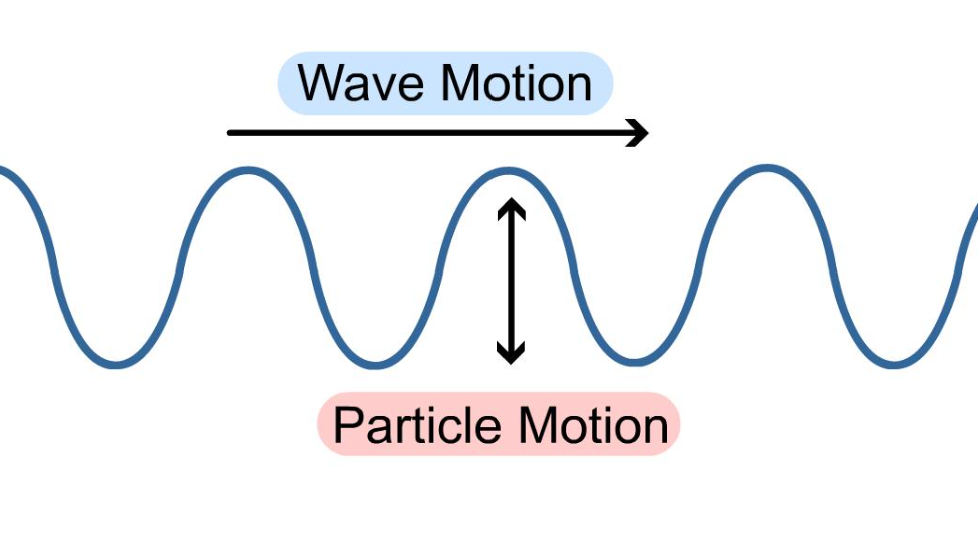Edexcel iGCSE Physics
0.0(0)
0.0(0)
Card Sorting
1/123
Earn XP
Description and Tags
Study Analytics
Name | Mastery | Learn | Test | Matching | Spaced |
|---|
No study sessions yet.
124 Terms
1
New cards
Speed Formula
Speed (m/s) = Distance (m) / Time (s)
2
New cards
What do the flat parts of a distance-time graph tell you?
That the graph is stationary
3
New cards
What does the gradient of a distance-time graph tell you?
The speed
4
New cards
Acceleration Formula
Acceleration (m/s^2) = (final speed - initial speed) / time
\
a = (v - u) / t
\
a = (v - u) / t
5
New cards
How to calculate the distance travelled on a speed-time graph?
The area under the graph
\
\* Area of a triangle = 1/2 x b x h
\
\* Area of a triangle = 1/2 x b x h
6
New cards
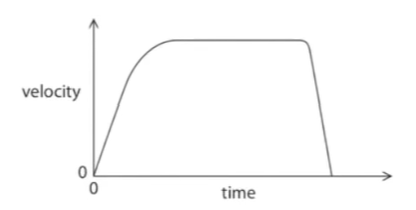
The graph shows hot its velocity changes with time.
Constant velocity is shown by:
**A.** The area under the line
**B.** The horizontal part of the line
**C.** The sloping line at the end
**D.** The sloping line at the start
Constant velocity is shown by:
**A.** The area under the line
**B.** The horizontal part of the line
**C.** The sloping line at the end
**D.** The sloping line at the start
**B.** The horizontal part of the line
7
New cards
What does the gradient of a speed-time graph tell you?
The acceleration
8
New cards
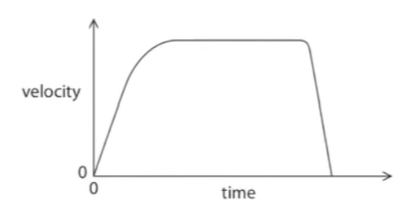
The graph shows how its velocity changes over time.
\
The distance travelled is shown by:
**A.** The area under the line
**B.** The horizontal part of the line
**C.** The sloping line at the end
**D.** The sloping line at the start
\
The distance travelled is shown by:
**A.** The area under the line
**B.** The horizontal part of the line
**C.** The sloping line at the end
**D.** The sloping line at the start
**A.** The area under the line
9
New cards
The graph shows how a car’s velocity changes over time.
\
The average velocity of the car is given by:
**A.** The change in velocity divided by the time taken
**B.** The distance moved divided by the time taken
**C.** The time taken divided by the change in velocity
**D.** The time taken divided by the distance moved
\
The average velocity of the car is given by:
**A.** The change in velocity divided by the time taken
**B.** The distance moved divided by the time taken
**C.** The time taken divided by the change in velocity
**D.** The time taken divided by the distance moved
**B.** The distance moved divided by the time taken
10
New cards
Difference between scalar and vector
Scalar = Magnitude only
Vector = Magnitude __and__ direction
Vector = Magnitude __and__ direction
11
New cards
Vector quantities
* Acceleration
* Velocity
* Force
* Displacement
* Momentum
* Weight
*Everything else is scalar*
* Velocity
* Force
* Displacement
* Momentum
* Weight
*Everything else is scalar*
12
New cards
Weight
Unit: Newtons (N)
\
Takes into account gravity; Weight will be different on Mars than it is on Earth
\
Takes into account gravity; Weight will be different on Mars than it is on Earth
13
New cards
Mass
Unit: Kilograms (Kg)
\
Mass stays the same; if mass = 50kg on Earth, it will equal 50 kg on Mars
\
Mass stays the same; if mass = 50kg on Earth, it will equal 50 kg on Mars
14
New cards
State the equation linking Weight and Mass
Weight (N) = Mass (kg) x Gravitational Field Strength (earth = 10)
\
e.g.
On earth:
Weight = 50kg x 10
Weight = 500 N
\
On moon:
Weight = 50kg x 1.6
Weight = 80 N
\
e.g.
On earth:
Weight = 50kg x 10
Weight = 500 N
\
On moon:
Weight = 50kg x 1.6
Weight = 80 N
15
New cards
List the different types of forces:
* Gravitational
* Electrostatic
* Weight
* Friction
* Air Resistance
* Upthrust
* Nuclear
* Magnetic
* Normal Reaction
* Electrostatic
* Weight
* Friction
* Air Resistance
* Upthrust
* Nuclear
* Magnetic
* Normal Reaction
16
New cards
Magnetic Force
Experienced by any magnetic material in a magnetic field
e.g.
* Opposite magnetic poles (N-S or S-N) attract each other
* Like magnetic poles (N-N or S-S) repel each other
e.g.
* Opposite magnetic poles (N-S or S-N) attract each other
* Like magnetic poles (N-N or S-S) repel each other
17
New cards
Electrostatic Force
Experienced by any charged particle in an electric field
e.g.
* Opposite charges (+ and -) attract
* Like charges ( - and -, or + and +) repel
e.g.
* Opposite charges (+ and -) attract
* Like charges ( - and -, or + and +) repel
18
New cards
Tension Force
Pulling force exerted by each end of an object (such as a string or rope)
\
An object that is being stretched e.g. a cable holding a ceiling lamp.
\
An object that is being stretched e.g. a cable holding a ceiling lamp.
19
New cards
Reaction Force
An object at rest on a surface e.g. a book on a table
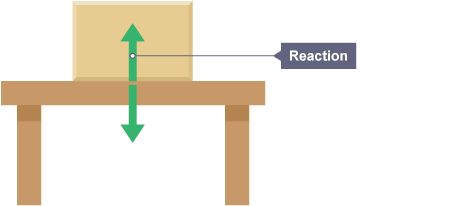
20
New cards
Friction Force
A force that opposes or prevents movement and converts KE into heat
\
Two objects sliding past each other e.g. a box sliding down a slope
\
Two objects sliding past each other e.g. a box sliding down a slope
21
New cards
Air Resistance Force
A force of friction that is produced when an object moves through the air. Air particles collide with the object and slow it down.
\
An object moving through the air e.g. a skydiver falling through the air
\
An object moving through the air e.g. a skydiver falling through the air
22
New cards
Gravitational Force
A gravitational force is experienced by any mass in a gravitational field.
\
Masses are attracted towards each other by gravitational force.
\
Masses are attracted towards each other by gravitational force.
23
New cards
Weight
Force acting downwards on an object; takes into account weight and GFS
24
New cards
Balanced Forces definition
When 2 forces acting on an object are equal in size but act in opposite directions
25
New cards
What forces are acting on a car when it is moving?
Forward Force = Driving force from the engine
Opposing Forces = Air resistance (drag), Friction, Weight
Opposing Forces = Air resistance (drag), Friction, Weight
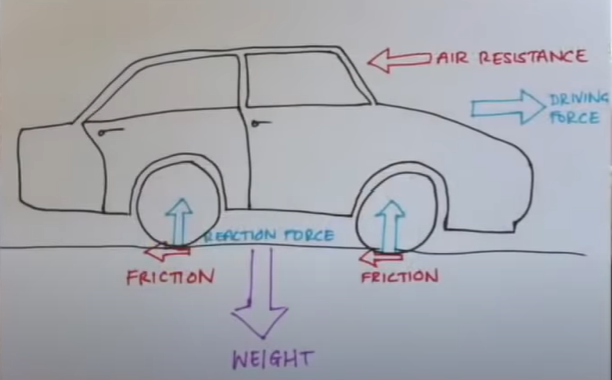
26
New cards
What is Newton’s First Law?
If forces acting on an object are balanced, the resultant force is zero
* Objects at rest remain stationary
* Object moving, continues to move in same direction and at same speed
* Objects at rest remain stationary
* Object moving, continues to move in same direction and at same speed
27
New cards
What is Newton’s Second Law?
Acceleration is proportional to resultant force and inversely proportional to mass of object
28
New cards
What is Newton’s Third Law?
Two objects exert equal and opposite forces on eachother
29
New cards
Describe Terminal Velocity in terms of a parachutist
1. The moment the sky-diver jumps, the only force acting on him is his %%**weight**%%. This ^^unbalanced^^ force causes him to **accelerate**
2. As he accelerates, the %%**air resistance**%% **increases**. Eventually, the two forces (weight and air resistance) are ^^balanced^^, so he stops accelerating and travels at constant speed, otherwise known as **terminal velocity**.
\
3. When his parachute opens, the %%**air resistance**%% **increases**. There is now a resultant force upwards, making him slow down until the two forces (weight and air resistance) ^^balance^^ again. This is his new **terminal velocity**. It will be much smaller than the original velocity, due to the opening of his parachute.
30
New cards
State the equation linking Force and Acceleration
Force (N) = Acceleration (m/s^2) x Mass (kg)
31
New cards
Calculate the resultant force required to accelerate a 30 kg object at 1.5 m/s^2
F = m x a
F = 30 x 1.5
F = 45 N
F = 30 x 1.5
F = 45 N
32
New cards
What does Hooke’s Law state?
Extension is directly proportional to stretching force
33
New cards
Hooke’s Law equation
force (N) = spring constant (N/m) × extension (m)
F= k e
F= k e
34
New cards
A force of 3 N is applied to a spring. The spring stretches reversibly by 0.15 m
\
Calculate the spring constant
\
Calculate the spring constant
F = k e
3 = k x 0.15
k = 3/0.15
k = 20 N/m
3 = k x 0.15
k = 3/0.15
k = 20 N/m
35
New cards
What is spring constant (Hooke’s Law)?
A measure of the stiffness of a spring up to its limit of proportionality or elastic limit.
36
New cards
What is the limit of proportionality (Hooke’s Law)?
The point beyond which Hooke's law is no longer true when stretching a material
37
New cards
What does the elastic limit of a material mean?
It has reached the furthest point it can be stretched or deformed while being able to return to its previous shape.
\
Once a material has gone past its elastic limit, its deformation is said to be **inelastic**.
\
Once a material has gone past its elastic limit, its deformation is said to be **inelastic**.
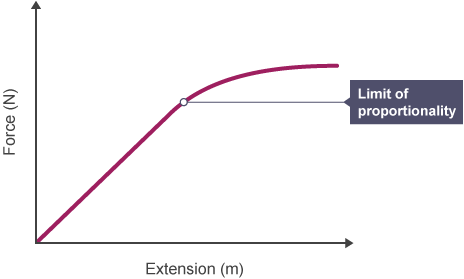
38
New cards
Explain how a student can investigate whether a spring obeys Hooke’s Law
* Measure original length of spring using metre ruler
* Add known weight to hook
* Measure new length of spring
* Repeat using rage of different known weights
* Repeat experiment and take average extension for each weight
* Add known weight to hook
* Measure new length of spring
* Repeat using rage of different known weights
* Repeat experiment and take average extension for each weight
39
New cards
Momentum Equation
Momentum (kg m/s)= Mass (kg) x Velocity (m/s^2)
40
New cards
What is the momentum of a bullet of mass 50g travelling at 300m/s?
Mass = 50/1000 = 0.05kg
\
Momentum = 0.05 x 300 = 15 kg m/s
\
Momentum = 0.05 x 300 = 15 kg m/s
41
New cards
Emma is standing still and fires a rifle. The bullet has a mass of 0.045 kg and is travelling at 350m/s. If Emma has a mass of 60kg, with what velocity does she move backwards?
Momentum is conserved (it doesn’t change)
Momentum before = Momentum after
\
(0 x 60) + (0 x 0.045) = (60 x v) + (0.045 x 350)
0 = 60v + 15.75
\-15.75 = 60v
\
Velocity = -0.2625 m/s
Momentum before = Momentum after
\
(0 x 60) + (0 x 0.045) = (60 x v) + (0.045 x 350)
0 = 60v + 15.75
\-15.75 = 60v
\
Velocity = -0.2625 m/s
42
New cards
A boy of mass 50kg on ice skates throws a ball of 1kg in front of him at a velocity of 2.5 m/s. What is the boy’s velocity?
Momentum is conserved
Momentum before = Momentum after
\
(0 x 50) + (0 x 1) = (50 x v) + (1 x 2.5)
0 = 50v + 2.5
\-2.5 = 50v
\
Velocity = -0.05 m/s
Momentum before = Momentum after
\
(0 x 50) + (0 x 1) = (50 x v) + (1 x 2.5)
0 = 50v + 2.5
\-2.5 = 50v
\
Velocity = -0.05 m/s
43
New cards
A car of mass 1000 kg travelling at a velocity of 20 m/s collided with a stationary motorbike of mass 500 kg. The vehicles move together after impact. Calculate their velocity.
Momentum is conserved
Momentum before = Momentum after
\
(1000 x 20) + (500 x 0) = (1000 + 500) x v
20,000 = 1500v
Velocity = 13.3m/s
Momentum before = Momentum after
\
(1000 x 20) + (500 x 0) = (1000 + 500) x v
20,000 = 1500v
Velocity = 13.3m/s
44
New cards
A car travelling at 20m/s collides with a stationary lorry and is brought to a rest in 0.02s. A woman in the car has a mass of 50kg. What force does she experience?
Force = Change in momentum / time
\
F = ((20 x 50) - (50 x 0)) / 0.02
F = 1000 / 0.02
F = 50000N
\
F = ((20 x 50) - (50 x 0)) / 0.02
F = 1000 / 0.02
F = 50000N
45
New cards
Moment Formula
Moment (Nm) = Force (N) x Perpendicular distance (m)
\
(A moment is a turning effect)
\
(A moment is a turning effect)
46
New cards
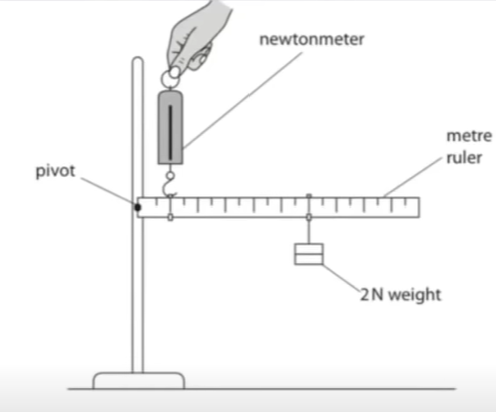
The 2N weight is placed 60cm from the pivot.
The newton metre is placed 10cm from the pivot.
Calculate the reading on the newton meter. (Ignore the weight of the ruler)
The newton metre is placed 10cm from the pivot.
Calculate the reading on the newton meter. (Ignore the weight of the ruler)
Distance = 60 / 100 = 0.6m
\
%%Clockwise moment%% = ^^Anticlockwise moment^^
%%0.6 x 2%% = ^^w x 0.1^^
%%1.2%% = ^^0.1w^^
\
Weight = 12N
\
%%Clockwise moment%% = ^^Anticlockwise moment^^
%%0.6 x 2%% = ^^w x 0.1^^
%%1.2%% = ^^0.1w^^
\
Weight = 12N
47
New cards
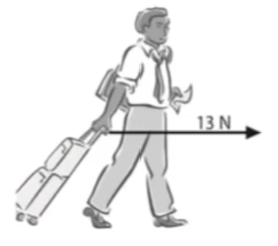
The person pulls the suitcase with a horizontal force of 13N for 110m.
Calculate the work done on the suitcase by the person.
Calculate the work done on the suitcase by the person.
W = F x D = 13 x 110
W = 1430J
W = 1430J
48
New cards
State the equation linking work done, force and distance moved
Work Done (J) = Force (N) x Distance (m)
49
New cards
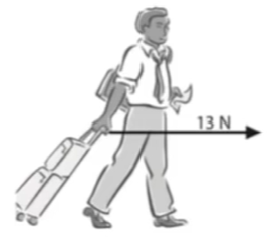
The person pulls the suitcase with a horizontal force of 13N for 110m.
How much energy is transferred to the suitcase?
How much energy is transferred to the suitcase?
1430J
50
New cards
A suitcase falls over. \\explain why it loses gravitational potential energy when it falls
* GPE = Mass x Gravity x Height
* ∴ GPE depends on height
* As it falls, height will decrease, so GPE will as well.
* ∴ GPE depends on height
* As it falls, height will decrease, so GPE will as well.
51
New cards
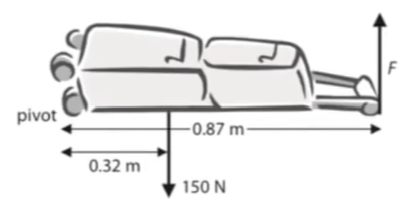
A person raises a suitcase by pulling on the handle with force *F.* The weight of the suitcase is 150 N.
Calculate the force *F* that the person must apply on the handle to start raising the suitcase
Calculate the force *F* that the person must apply on the handle to start raising the suitcase
Clockwise moment = Anticlockwise moment
150 x 0.32 = F x 0.87
16 = 0.87F
\
Force = 18.39 N
150 x 0.32 = F x 0.87
16 = 0.87F
\
Force = 18.39 N
52
New cards
Define ‘centre of mass’
The point where the mass appears to be concentrated
53
New cards
How do you find the centre or mass of an asymmetric object?
* Suspend card from a pivot
* Attach a plumb line
* Draw vertical line on card where string rests
* Suspend car from a second point
* Where 2 lines cross = centre of mass
* Attach a plumb line
* Draw vertical line on card where string rests
* Suspend car from a second point
* Where 2 lines cross = centre of mass
54
New cards

What electrical component is this?
Battery
55
New cards
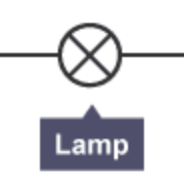
What electrical component is this?
Lamp
56
New cards
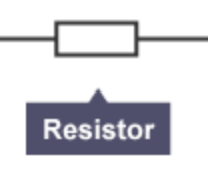
What electrical component is this?
Resistor
57
New cards

What electrical component is this?
Variable Resistor
* Can alter the resistance of the circuit
* Can alter the resistance of the circuit
58
New cards
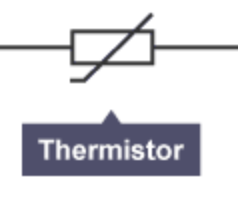
What electrical component is this?
Thermistor
* Temperature dependent resistor
* At low temperatures, the thermistor has a high resistance.
* As the temperature increases, the resistance decreases.
* Temperature dependent resistor
* At low temperatures, the thermistor has a high resistance.
* As the temperature increases, the resistance decreases.
59
New cards
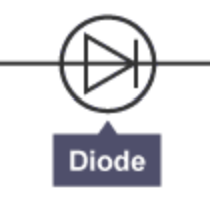
What electrical component is this?
Diode
* Allows the current to flow in one direction only (direction arrow is pointing)
* Allows the current to flow in one direction only (direction arrow is pointing)
60
New cards
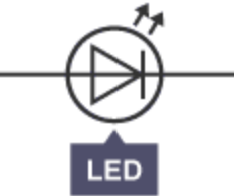
What electrical component is this?
Light Emitting Diode (LED)
61
New cards

What electrical component is this?
Light Dependent Resistor (LDR)
* The resistance of a LDR depends on light intensity.
* At low light levels, the LDR has a high resistance.
* As the light intensity increases, the resistance decreases.
* The resistance of a LDR depends on light intensity.
* At low light levels, the LDR has a high resistance.
* As the light intensity increases, the resistance decreases.
62
New cards
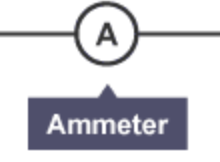
What electrical component is this?
Ammeter
* Measures the current of a circuit
* Added in series
* Measures the current of a circuit
* Added in series
63
New cards
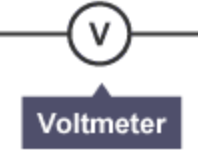
What electrical component is this?
Voltmeter
* Measures the voltage of a circuit
* Added in parallel around the component in question
* Measures the voltage of a circuit
* Added in parallel around the component in question
64
New cards
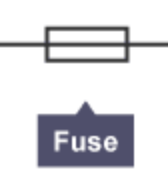
What electrical component is this?
Fuse
* Safety device that melts when the current is too high, breaking the circuit
* Safety device that melts when the current is too high, breaking the circuit
65
New cards
What are the advantages of using a circuit breaker, as opposed to a fuse?
A circuit breaker is much faster and easier to reset. Simply push a button and the circuit can be reset again, whereas with a fuse, a complete replacement would be needed.
66
New cards
Voltage Formula
Voltage (V) = Current (A) x Resistance (Ω)
V = I x R
V = I x R
67
New cards
Charge Formula
Charge (C) = Current (A) x Time (s)
C = I x t
C = I x t
68
New cards
Why does the resistance increase when the temperature increases?
* A wire is made up of positive metal ions and negative electrons
* When the wire is heated, the positive ions will vibrate because they have more kinetic energy
* This will inhibit the flow of electrons through the metal wire
* When the wire is heated, the positive ions will vibrate because they have more kinetic energy
* This will inhibit the flow of electrons through the metal wire
69
New cards
Ohm’s Law
The current through a resistor at constant temperature is directly proportional to the potential difference across the resistor
70
New cards
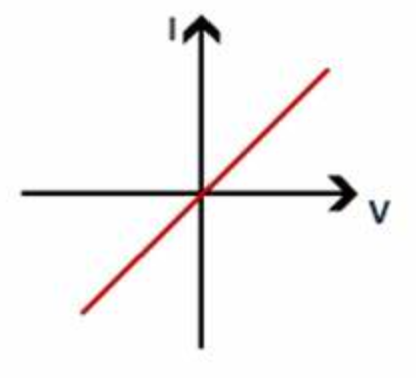
What component is this Current-Voltage graph?
**Wire**
* The current through a wire (constant temp.) is directly proportional to voltage
* Ohmic
* Also true for different resistors, just with different gradients)
* The current through a wire (constant temp.) is directly proportional to voltage
* Ohmic
* Also true for different resistors, just with different gradients)
71
New cards

What component is this Current-Voltage graph?
**Metal Filament Lamp**
* As the temperature of the metal filament increases, the resistance increases, hence the curve
* Non-Ohmic
* As the temperature of the metal filament increases, the resistance increases, hence the curve
* Non-Ohmic
72
New cards

What component is this Current-Voltage graph?
**Diode**
* Current will only flow through a diode in one direction; it has a very high resistance in the other direction
* Non-Ohmic
* Current will only flow through a diode in one direction; it has a very high resistance in the other direction
* Non-Ohmic
73
New cards
Current and Voltage rules in a **series** circuit
* Current is the __same__ everywhere
* Voltage of individual components adds up to the total voltage
* Voltage of individual components adds up to the total voltage
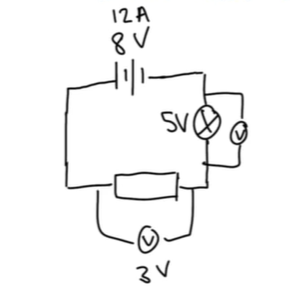
74
New cards
Current and Voltage rules in a **parallel** circuit
* Voltage is the __same__ everywhere
* Current of individual components adds up to the total current
* Current of individual components adds up to the total current

75
New cards
Why are __fraying cables__ dangerous when using mains electricity in the home?
Potential electrocution risk
76
New cards
Why are __long cables__ dangerous when using mains electricity in the home?
Tripping hazard
77
New cards
Why is __water (and metal objects)__ dangerous when using mains electricity in the home?
Conduct electricity and could electrocute you
78
New cards
What is the green and yellow wire in a plug
**Earth wire**
* Carries the charge into the earth if a problem occurs
* Carries the charge into the earth if a problem occurs
79
New cards
What is the brown wire in a plug?
**Live wire**
* Alternates between a positive and negative voltage of about %%230V%%
* Alternates between a positive and negative voltage of about %%230V%%
80
New cards
What is the blue wire in the plug?
**Neutral wire**
* Always at 0V
* Always at 0V
81
New cards
What is double insulation and why is it used?
Both the wires inside a device and the outer case of the device are insulated. This means there is no chance of electrocution.
82
New cards
What is an electric current?
A flow of charge
83
New cards
Describe alternating current
A current which changes direction continuously
84
New cards
Describe direct current
A current which flows in one direction only
85
New cards
What is a circuit breaker?
A device which stops the current flowing in a circuit when the current is too high by breaking the circuit
86
New cards
A 4V battery can supply a current of 5A for 20 minutes before it needs recharging.
Calculate how much charge the battery can provide before it needs recharging
Calculate how much charge the battery can provide before it needs recharging
V = I x R
Q = I x T
W = V x Q
\
Charge = Current x Time = 5 x (20 x 60)
\
Charge = 6000C
Q = I x T
W = V x Q
\
Charge = Current x Time = 5 x (20 x 60)
\
Charge = 6000C
87
New cards
A 4V battery can supply a current of 5A for 20 minutes before it needs recharging.
Each coulomb of charge from the battery can carry 3J of energy. Calculate how much work the battery can do before it needs recharging.
Each coulomb of charge from the battery can carry 3J of energy. Calculate how much work the battery can do before it needs recharging.
W = V x Q = 4 x 6000
\
Work Done = 24000J
\
Work Done = 24000J
88
New cards
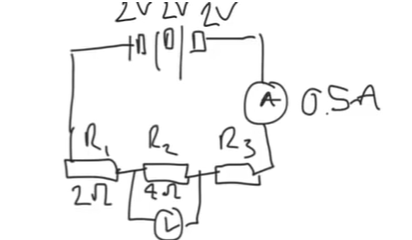
Calculate the total potential difference across the battery
Potential Difference = Voltage
\
2 + 2 + 2 = 6V
\
2 + 2 + 2 = 6V
89
New cards

Work out the total resistance
R = V / I = 6 / 0.5
R = 12 Ω
R = 12 Ω
90
New cards
What is a static charge?
A charge that build up in one place and is not free to move.
91
New cards
Why is static charge more common on insulators?
Because current can’t flow, so the charge gets stuck on the insulator
92
New cards
What is the most common cause of static charge? How does it happen?
**Friction**
* Two insulating materials are rubbed together, and electrons will be scraped off one and dumped on the other
* This leaves a positive electrostatic charge on one and a negative electrostatic charge on the other
* Two insulating materials are rubbed together, and electrons will be scraped off one and dumped on the other
* This leaves a positive electrostatic charge on one and a negative electrostatic charge on the other
93
New cards
Explain how voltage increases when static charge builds up
* An electric charge builds on an isolated object
* The voltage between the object and the earth (which is 0V) increases
* If the voltage gets large enough, electrons jump across the gap between the charged objects and the earth - a spark
* The voltage between the object and the earth (which is 0V) increases
* If the voltage gets large enough, electrons jump across the gap between the charged objects and the earth - a spark
94
New cards
Explain how a student can investigate static charges with acetate and polythene rods and a cloth duster
**Polythene rod** is rubbed with duster:
* Electrons move from the duster to the rod
* Rod = negatively charged
* Duster = positively charged
\
**Acetate rod** is rubbed with duster:
* Electrons move from rod to duster
* Rod = positively charged
* Duster = negatively charged
* Electrons move from the duster to the rod
* Rod = negatively charged
* Duster = positively charged
\
**Acetate rod** is rubbed with duster:
* Electrons move from rod to duster
* Rod = positively charged
* Duster = negatively charged
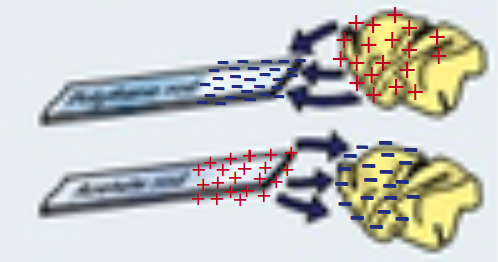
95
New cards
Why does a balloon stick to a wall?
* Charged it using friction
* Balloon has become negatively charged due to the transfer of electrons
* Sticks to the wall because it repels those electrons away from the wall meaning it can stick to the positive charges
* Balloon has become negatively charged due to the transfer of electrons
* Sticks to the wall because it repels those electrons away from the wall meaning it can stick to the positive charges
96
New cards
Why does ___ become charged?
* Transfer of electrons
* Charging by friction
* Charging by friction
97
New cards
Why does your hair stand on end when you touch a Van de Graff generator?
* All your hairs become negatively charged
* They therefore repel, so they stand on end
* They therefore repel, so they stand on end
98
New cards
Uses of static electricity
**Painting a bike frame**
* Bike given a positive charge
* Paint given a negative charge
* Paint droplets repel themselves and turns into a fine mist
* This is attracted to the positive bike frame
\
**Inkjet Printer**
* Ink is given a charge
* Deflected as they pass between two metal plates. A voltage is applied to the plates (+ve and -ve)
* Electrostatic forces direct it into place
\
**Photocopier**
* Rotating drum is given a charge
* Image of paper is projected onto the drum
* The charge leaks away
* Toner is attracted to charged areas
* Heat sticks the image onto the paper
* Bike given a positive charge
* Paint given a negative charge
* Paint droplets repel themselves and turns into a fine mist
* This is attracted to the positive bike frame
\
**Inkjet Printer**
* Ink is given a charge
* Deflected as they pass between two metal plates. A voltage is applied to the plates (+ve and -ve)
* Electrostatic forces direct it into place
\
**Photocopier**
* Rotating drum is given a charge
* Image of paper is projected onto the drum
* The charge leaks away
* Toner is attracted to charged areas
* Heat sticks the image onto the paper
99
New cards
Dangers of static electricity
**Lightning**
* Rain and ice bump together inside storm clouds
* Knocks off electrons, leaving the top of the cloud positively charged and the bottom of the cloud negative
* Creates a huge voltage and a big spark
\
**Fuel-filling**
* Fuel flows out of a filler pipe and static builds up
* Leads to a spark
* In dusty/fumy places, this will lead to an explosion
* Solution: Make the nozzles out of metal so that the charge is conducted away, and have earthing straps to carry the charge away
* Rain and ice bump together inside storm clouds
* Knocks off electrons, leaving the top of the cloud positively charged and the bottom of the cloud negative
* Creates a huge voltage and a big spark
\
**Fuel-filling**
* Fuel flows out of a filler pipe and static builds up
* Leads to a spark
* In dusty/fumy places, this will lead to an explosion
* Solution: Make the nozzles out of metal so that the charge is conducted away, and have earthing straps to carry the charge away
100
New cards
Transverse Waves
Vibrations occur perpendicular (90) to the direction in which the wave is travelling
\
e.g. EM waves, Ripples on water, a slinky wiggled up and down
\
e.g. EM waves, Ripples on water, a slinky wiggled up and down
